These Sample papers are part of CBSE Sample Papers for Class 12 Biology. Here we have given CBSE Sample Papers for Class 12 Biology Paper 2.
CBSE Sample Papers for Class 12 Biology Paper 2
| Board | CBSE |
| Class | XII |
| Subject | Biology |
| Sample Paper Set | Paper 2 |
| Category | CBSE Sample Papers |
Students who are going to appear for CBSE Class 12 Examinations are advised to practice the CBSE sample papers given here which is designed as per the latest Syllabus and marking scheme as prescribed by the CBSE is given here. Paper 2 of Solved CBSE Sample Paper for Class 12 Biology is given below with free PDF download solutions.
Time: 3 Hours
Maximum Marks: 100
General Instructions:
- There are total 26 questions and five sections in the question paper. All questions are compulsory.
- Section A contains question number 1 to 5, Very Short Answer Type Questions of one mark each.
- Section B contains question number 6 to 10, Short Answer Type Questions of two marks each.
- Section C contains question number 11 to 22, Short Answer Type Questions of three marks each.
- Section D contains question number 23, Value Based Question of four mark.
- Section E contains question number 24 to 26, Long Answer Type Questions of five marks each.
- There is no overall choice in the question paper, however, an internal choice is provided in one question of two marks, one question of three marks and all three questions of five marks. An examiner is to attempt any one of the question out of the two given in the question paper with the same question number.
- No. of printed pages are three.
SECTION-A
Question 1.
A certain tissue, of a plant, infected with TMV was used to obtain a new plant using tissue culture technique. Identify the technique used and reason out the possibility of obtaining a new healthy plant.
Question 2.
State a method of cellular defense which works in all eukaryotic organisms.
Question 3.
In case of an infertile couple, the male partner can inseminate normally but the mobility of sperms is below 40 percent. Judge, which kind of ART is suitable in this situation to form an embryo in the laboratory, without involving a donor?
Question 4.
PCR requires very high temperature conditions where most of the enzymes get denatured.How was this problem resolved in a PCR?
Question 5.
If two genes are located far apart from each other on a chromosome, what will be its effect on the frequency of recombination?
SECTION-B
Question 6.
The alarming population growth is leading to scarcity of basic requirements. Suggest with reason, any two population control measures other than contraception to address the situation.
Question 7.
Both Down’s syndrome and Turner’s syndrome are examples of chromosomal disorders. Cite the differences between the two, at the chromosomal level.
Question 8.
To reduce the percentage of population suffering from hunger and malnutrition, microbes are grown on a large scale to act as food supplements. Mention any two microbes used as food supplement and suggest their role.
OR
Success rate of artificial insemination in cattle is fairly low. Identify any other technique to improve the successful production of hybrids. State two advantages of this technique
Question 9.
(a) A patient who is suffering from myocardial infarction is given a clot buster as part of his treatment. Mention the clot buster administered and its microbial source.
(b) A person recuperating from illness is advised to have curd regularly. Why?
Question 10.
Assess the effects of loss of biodiversity in a region. Mention any four such effects.
SECTION-C
Question 11.
Draw and label the enlarged view of microsporangium of an Angiosperm. State the function of its innermost wall layer.
Question 12.

(a) State the type of gametes shown in the diagram.
(b) Identify the process taking place and the resultant structure,
(c) Name an organism that reproduces in this manner.
Question 13.
Diagrammatically represent the experimental set up that proved Oparin – Haldane hypothesis.
Question 14.
True-breeding pea plants showing contrasting character for flower position were cross-bred.
(a) Mention the position of flowers in F1 generation.
(b) Work out the cross up to F2 generation.
(c) Compute the relative fraction of various genotypes in the F2 generation. Axial position
Question 15.
Your classmate complains of headache and cough. The doctor confirms that he is suffering from Pneumonia and not common cold, on the basis of certain symptoms. List these symptoms. Mention any two precautions to be followed to prevent the spread of this disease.
Question 16.
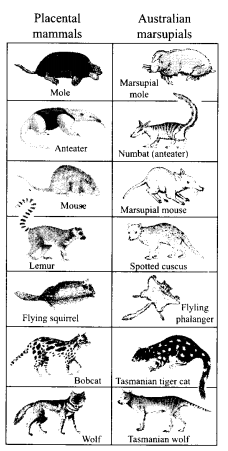
Refer to the figure given below and answer the questions that follow:
(a) Explain the process by which Tasmanian wolf evolved.
(b) Name the process that has resulted in evolution of wolf and another similar animal such as Tasmanian wolf.
(c) Compare and contrast the two animals shown.
Question 17.
Cow dung and water is mixed and this slurry is fed into the biogas plant for digestion by microbes. The person performing the process shares that there is no need to provide inoculums for it, why? What is the role of microbes at the source? Under which condition will they be most active and effective?
Question 18.
A person is born with a hereditary disease with a weakened immune system due to deficiency of an enzyme. Suggest a technique for complete cure for this disease, identify the deficient enzyme and explain the technique used for cure.
Question 19.
A doctor prescribed morphine as a sedative and pain killer to your cousin who had undergone surgery. Even after recovery, he craved for the prescribed medicine. What do you conclude about his condition, had he continued with the same medication? After appraising yourself, what measures will you suggest to him to overcome this problem? Briefly explain any two.
Question 20.
Given below is the diagram of agarose gel kept under UV light:
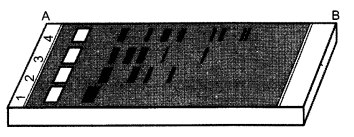
(a) Mark the positive and negative terminals.
(b) What is the charge carried by DNA molecule and how does it help in its separation?
(c) How are the separated DNA fragments finally isolated?
OR
(a) CrylAb is introduced in a plant to prevent infestation by com borer.
(b) What is the resultant plant referred as?
(c) Summarize the action of the gene introduced.
Question 21.
The graph given below shows the distribution of biomes:
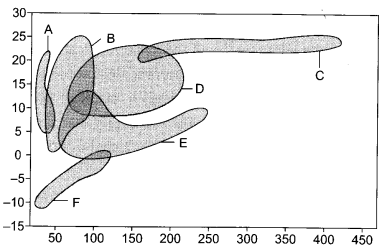
(a) What do the ‘X’ and ‘Y’ axes represent?
(b) Identify the ‘grassland’ and ‘coniferous forest’ biomes, from the above figure.
(c) Why is ‘F’ located at the given position in the graph?
Question 22.
(a) In pBR322, foreign DNA has to be introduced in tet R region. From the restriction enzymes given below, which one should be used and why:
Pvu, EcoR I, BamH I
(b) Give reasons, why the other two enzymes cannot be used.
SECTION-D
Question 23.
A son persuades his father to replace his old mobile phone with the latest model launched in the market. He also shares the latest features it has and explains how it can be of a help to him in the modem technological world. Father is reluctant in buying a new one and tries to explain about its environment impact. How do you think, the biologist father has tried to convince his son? Justify the arguments of father and son both, by mentioning positive aspects of the behavior displayed by both of them in the situation concerned (three each).
SECTION-E
Question 24.
Given below is the diagram of a human ovum surrounded by a few sperms. Observe the diagram and answer the following questions:
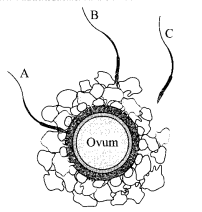
(a) Compare the fate of sperms shown in the diagram.
(b) What is he role of zona pellucida in this process?
(c) Analyze the changes occurring in the ovum during the process.
(d) How is the entry of sperm into the ovum facilitated?
(e) Specify the region of female reproductive system where the event represented in the diagram takes place.
OR
The graph given below shows the variation in the levels of ovarian hormones during various phases of menstrual cycle:

(a) Identify ‘A’ and ‘B’
(b) Specify the source of the hormone marked in the diagram.
(c) Reason out why A peaks before B.
(d) Compare the role of A and B.
(e) Under which condition will the level of B continue to remain high on the 28th day?
Question 25.
Explain the process of protein synthesis from processed m-RNA.
OR
Which methodology is used while sequencing the total DNA from a cell? Explain it in detail.
Question 26.
Citing lake as an example of a simple aquatic ecosystem, interpret how various functions of this ecosystem are carried out. Make a food chain that is functional in this ecosystem.
OR
(a) Colonization of a rocky terrain is a natural process. Mention the group of organisms which invade this area first. Given an example.
(b) Over the years, it has been observed that some of the lakes are disappearing due to urbanization. In absence of human interference, depict by making a flow chart, how do the successional series progress from hydric to mesic condition.
(c) Identify the climax community of hydrarch and xerarch succession.
Answers
SECTION-A
Answer 1.
Tissue culture using meristematic tissue as it is virus free.
Answer 2.
RNA interference.
Answer 3.
Intra Cytoplasmic Sperm Injection.
Answer 4.
The use of a thermostable DNA polymerase Thermus aquaticus which remain active during the high temperature induced denaturation of double stranded DNA.
Answer 5.
Ans. Frequency of recombination will be higher.
SECTION-B
Answer 6.
Population control measures other than contraception are:
(1) Advertisements in the media, to generate awareness about benefits of small families.
(2) Statutory raising of marriageable age of the female to 18 years and that of males to 21 years, to delay the number of births.
(3) Incentives given to couples with small families, to motivate others to comply.
(Any two of the above measures with explanation)
Answer 7.
| Down’s Syndrome | Turner’s Syndrome |
| 1. Occurs due Trisomy of Chromosome number 21. | 1. Occurs due to monosomy of X chromosome. |
| 2. Total number of Chromosome is 47. | 2. Total number of Chromosome is 45. |
Answer 8.
(1) Spirulina – Produces large quantities of food rich in protein, minerals, fats, carbohydrates and vitamins.
(2) Methylophilus methylotrophus – 250 gm of this micro-organism produces 25 tonnes of protein per day.
OR
Other technique to improve successful production of hybrids is MOET (Multiple Ovulation Embryo Transfer Technology). Two advantages of this technique:
(a) Increases herd size in short time of desired traits.
(b ) Increased chances of fertilisation and reproductive rate of individuals or groups of animals.
Answer 9.
(a) Streptokinase, Streptococcus.
(b) Curd contains Lactic Acid bacteria (LAB), which plays a beneficial role in checking disease causing microbes. It is a source of vitamin B12
Answer 10.
(1) Decline in plant production and number of animal species.
(2) Lowered resistance to environment perturbations such as drought.
(3) Increased variability in certain ecosystem processes such as plant productivity, water use, pest and disease cycles.
(4) Species may become endangered by increased rate of species extinction.
SECTION-C
Answer 11.

Tapetum, innermost wall layer nourishes the developing pollen grains.
Answer 12.
(a) Isogametes
(b) Fertilization and zygote
(c) Cladophora/Clamydomonas
Answer 13.
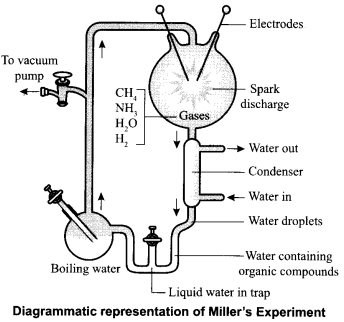
Answer 14.
(a) Axial position
(b)

(c)
The relative frequency of the genotypes in F2 generation is:
Homozygous dominant (AA) = 1/4 = 0.25
Heterozygous dominant (Aa) = 2/4 = 0.5
Homozygous recessive (aa) = 1/4 = 0.25
Answer 15.
Doctor confirms pneumonia on the basis of the following symptoms – fever/chills/ grey – blue lips and finger nails (any two); and not common cold as the following symptoms are not observed – Nasal congestion/sore throat/hoarseness (any two).
Precautions-
- Cover the nose when near the patient.
- Do not share glasses and utensils/articles used by the infected person.
Answer 16.
(a) Adaptive radiation – The process of evolution of different species in a given geographical area starting from a point and literally radiating to other areas of geography (habitats).
(b) Convergent evolution
(c) Wolf is a placental mammal, whereas Tasmanian wolf is a marsupial mammal.
Answer 17.
As methanogens are already present in Cow dung, there is no need to provide inoculums for it.
Breakdown of cellulose.
Anaerobic conditon.
Answer 18.
Gene Therapy
Adenosine deaminase enzyme
Lymphocytes from the blood of the patient are grown in a culture, a functional ADA cDNA is introduced into these lymphocytes, which are subsequently returned to the patient. The permanent cure is done by introducing ADAA cDNA into cells at early embryonic stages.
Answer 19.
Drug dependence which is the tendency of the body to manifest a characteristic and unpleasant withdrawal syndrome if regular dose of drugs is abruptly discontinued/because of perceived benefits, drugs are frequently used repeatedly from which the person may not be able to get out.
Measures:
(a) Education and counseling him to face problems and stresses and channelize the energy into healthy pursuits like reading, music, yoga and other extracurricular activities.
(b) Seeking help from parents to get the appropriate and immediate guidance from them,
(c) Seeking professional and medical help to get rid of the problem completely with sufficient efforts and will power (any two).
Answer 20.
(a) Positive terminal – ‘B’
Negative terminal – ‘A’
(b) DNA being negatively charged, moves towards the positive electrode (anode)
(c) By elution – separated bands of DNA are cut out from the agarose gel and extracted from the gel piece.
OR
(a) Com.
(b) ‘Cry I Ab/ Bt toxin forms crystal protein containing toxic insecticidal protein. The Bt toxin protein exists as an inactive protein, but once an insect ingests it, it gets converted into an active form due to the alkaline pH of the gut which solubilizes the crystal. The activated toxin binds to the surface of mid gut and creates pores that cause swelling, lysis and eventually death of the insect.
Answer 21.
(a) ‘X’ axis – Mean annual precipitation (cm).
‘Y’ axis – Mean annual temperature (°C).
(b) Grassland – B.
Coniferous forest – E.
(c) The mean annual temperature ranges from – 12 to 20°C (error accepted ‘2) and mean annual precipitation ranges from 10-25 cm, these are the optimum conditions in tundra biome.
Answer 22.
(a) Bam H I should be used, as restriction site for this enzyme is present in tetR region.
(b) Pvu I will not be used, as restriction site for this enzyme is present in ampR region (not in tetR) EcoRl will not be used, as restriction site for this enzyme is not present in selectable market tetR.
SECTION-D
Answer 23.
Father explains that it will lead to generation of e-waste; Difficulty in recycling e-waste/ hazardous nature of recycling of e-waste/exposing workers to toxic substances present in e-waste (any one)
Son’s wish to update his father with modern techniques, Awareness about trends and technologies, well versed with their applicability in daily life (any other similar/appropriate values)
Concern for environment, scientific thinking, inquisitive nature, social awareness, judicious use of money, sense of responsibility (any other similar/appropriate values)
SECTION-E
Answer 24.
(a) A is able to penetrate/fertilize the ovum, whereas B is unable to penetrate/fertilize and will degenerate
(b) Zona pellucida ensures the entry of only one sperm into the ovum
(c) Induces completion of meiotic division of the secondary oocyte, formation of second polar body and a haploid ovum
(d) Enzymes of acrosome help the sperm to enter into the cytoplasm of the ovum through the zona pellucida and the plasma membrane.
(e) Ampullary- isthmic junction of the fallopian tube.
OR
(a)
A – Estrogen
B – Progesterone
(b)
A – Maturing ovarian follicle/Graafian follicle
B – Corpus luteum
Answer 25.
For initiation, the ribosome binds to the mature m RNA at the start codon (AUG) that is recognized by the initiator t – RNA. During elongation, charged t RNA sequentially binds to the appropriate codon in
m – RNA with the aniticodon present on tRNA. The ribosome moves from one codon to another adding amino acids one after the other to form polypeptide, i.e. translation. During termination, the release factor binds to stop codon (UAA, UAG, UGA), terminating translation and releasing the polypeptide chain.
OR
Methodology used is Sequence Annotation
(1) Total DNA from a cell is isolated and converted into random fragments of relatively smaller sizes and cloned in suitable host using specialized vectors.
(2) The cloning results in amplification of each piece of DNA fragment.
(3) The fragments are sequenced using automated DNA sequencers, these sequences are then arranged based on some overlapping regions present in them.
(4) This requires generation of overlapping fragments for sequencing.
Specialized computer based programmes are developed, and these sequences are subsequently annotated and assigned to each chromosome.
Answer 26.
Functions of ecosystem are:
(1) Productivity: It is the conversion of inorganic into organic material with the help of solar efiergy by the autotrophs.
(2) Energy flow: It is a unidirectional movement of energy towards higher trophic level and its dissipation and loss as heat to the environment.
(3) Decomposition: It involves fragmentation, leaching, catabolism, humification, mineralization by bacteria, fungi and flagellates (abundant at the bottom of lake).
(4) Nutrient cycling: It is the decomposition of dead matter to release the nutrients back to be re-used by the autotrophs .
Food chain in aquatic ecosystem (lake)
Phytoplanktons → Zooplanktons → Small fish → Big fish
OR
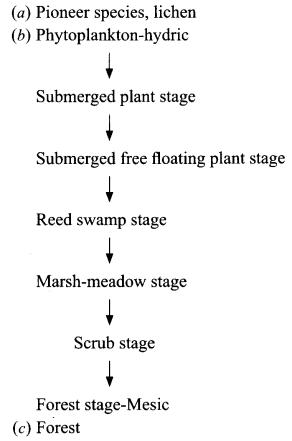
We hope the CBSE Sample Papers for Class 12 Biology Paper 2 help you. If you have any query regarding CBSE Sample Papers for Class 12 Biology Paper 2, drop a comment below and we will get back to you at the earliest.
